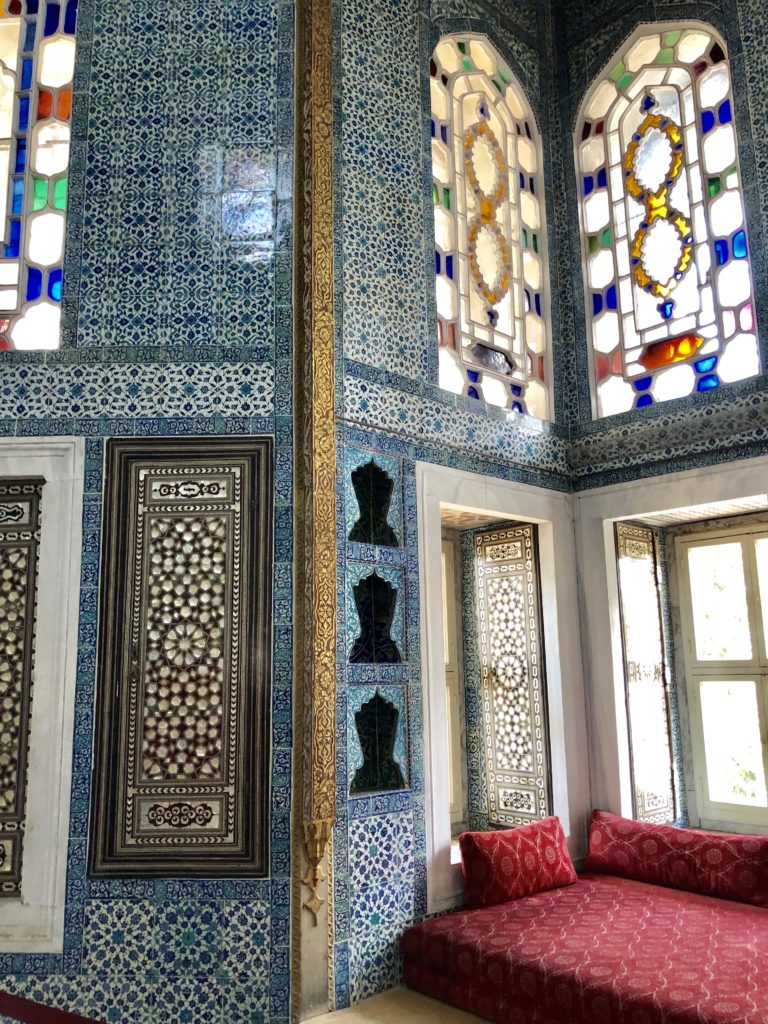When I was booking all of my flights with AirTreks, last May, I needed to get to Spain from Nepal. Aurelie, the travel person, told me that I would have a forced overnight in Istanbul, so if I wanted to spend a couple of days in Istanbul, there would be no extra charge. So, like our stopover in New Zealand, the 3 night/2 day stopover in Istanbul was not something that I planned as part of the itinerary, but it was such a delight!
We stayed at the Esans Hotel in the Old City, featuring colorful Turkish mosaic lamps, comfortable couches, and fast WiFi. It was run by three very cheerful young men. I asked Onor about things to do in the city, and he showed me some photos on his phone. It turns out he has more than 13,000 followers on Instagram via his “Istabul_streets” handle. James, one of the young filmmakers in Cambodia, also has more than ten thousand Instagram followers. James told me that because of his followers, he had been approached by some marketing companies to feature their products. I don’t know if anyone has approached Onor, but it is interesting to be, on one hand, in a worldwide position of influence on Instagram and on the other hand working the overnight shift at the hotel’s front desk.
Istanbul is known for being “where East meets West” because the city straddles the Bosphorus and has a foot in both Asia and Europe. Its history is known at least 600 BCE, but it may have been settled for up to six thousand years BCE. According to Wikipedia is the world’s fifth most popular tourist destination! As an eastern capital of the Roman Empire, Constantine (Constantinople!) wanted it to be known as “New Rome”. During the Middle Ages, it was the largest and wealthiest city in Europe and perhaps the world. It was conquered by the Ottoman Turks in 1453 and the grand cathedral of Hagia Sophia was converted into a mosque.
The Hagia Sophia was my favorite thing in our brief visit to Istanbul. It was a Christian church for almost a thousand years, and then it was a mosque for 500 years; it has been a museum since 1934. When the Ottoman Turks took it over and turned it into a mosque, they did not destroy the Christian imagery within, and so you see the image of the Virgin Mary along with Arabic religious script.
Declan loved the cats that prowled around the Hagia Sophia. There were lots of cats in Istanbul; there was even a geocache called “Cats of Istanbul”. I did a little bit of online investigation. Apparently, in Islam, cats are considered ritually clean animals, and the Prophet had a reported fondness for cats. They are considered guardians of the city for having defended libraries from destruction by mice and for protecting populations from rat-borne illnesses like the plague.
I thought about exploring some hip neighborhoods around the Bosphorus, but our time was too limited and we just stayed in the Old City. Blue Mosque (completed in 1616), Hagia Sophia, Topkapi Palace, and the Basilica Cistern. I really loved the Basilica Cistern. Known as the “Underground Palace”, it was built in the 6th century and is one of several hundred ancient cisterns beneath the city. It supplied the water for the Topkapi Palace; it is supported by a forest of marble columns. Most of the columns are Doric or Corinthian (thank you, Fernando, for quizzing me on the various types of columns, many years ago!), most “recycled” from the ruins of other structures in other parts of the empire and brought to Constantinople. Two of the columns feature the upside-down head of Medusa. It is not known if Medusa is upside down to protect views from turning to stone, or because it was more structurally sound to do it that way.
Topkapi Palace was also beautiful, although I did not have the heart to stand in the very long lines for some of the rooms. I had left Declan in the hotel room to play video games, because he was not interested in the palace, and I didn’t want to be away too long. I visited the harem at the end; it was a whole separate complex attached to the palace; the women in the harem were attended by eunuchs. It was lovely and interesting, but I was trying to hurry through it to get back to Declan, and of course there was only one way out. I thought that perhaps it might have been difficult for the women in the harem to consider any kind of escape!
Roasted chestnuts were sold on the streets, and roasted corn. Fresh squeezed orange juice was everywhere. Declan was on the lookout for Turkish Delight, which always reminds me of Edmund in “The Lion, The Witch, and the Wardrobe”. His teacher Ina at Near North brought Turkish Delight back for her students when she visited Turkey. Handsome Turkish men invited us to visit their carpet shops, but I turned them down with a smile and got us organized for a river trip on the Bosphorus.
So many mosques, so many beautiful buildings, so many expensive boats. I wish we had had more time to explore some of Istanbul’s neighborhoods. Our boat guide pointed out a mosque and a Christian church which shared a roof; different parts of the roof were topped with a cross and a crescent. Nearby was a Jewish temple. “This is our pride, here in Istanbul, ” he announced over the speaker. So nice, I thought. Some orange juice, some fresh watermelon, a geocache, and it was time to go to Spain.





















